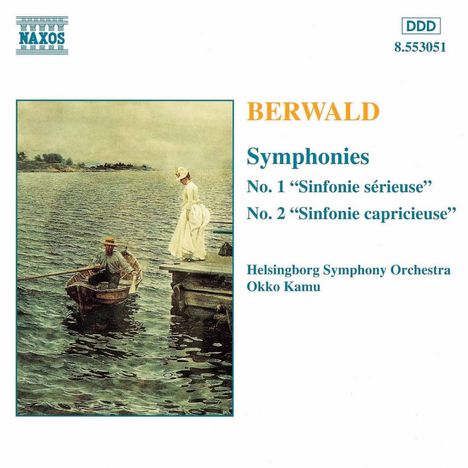Franz Berwald: Symphonien Nr.1 & 2 auf CD
Symphonien Nr.1 & 2
Herkömmliche CD, die mit allen CD-Playern und Computerlaufwerken, aber auch mit den meisten SACD- oder Multiplayern abspielbar ist.
Voraussichtlich wieder lieferbar Ende Januar 2026
(Nr. 1 in g "Serieuse";Nr. 2 in D "Capricieuse")
+Estrella de Soria-Ouvertüre
- Künstler:
- Helsingborg Symphony Orchestra, Okko Kamu
- Label:
- Naxos
- Aufnahmejahr ca.:
- 1995
- Artikelnummer:
- 7639315
- UPC/EAN:
- 0730099405126
- Erscheinungstermin:
- 27.2.1996
Berwalds Sinfonie serieuse wurde 1842 in Wien geschrieben und am 2. Dezember 1843 an der Königlichen Oper in Stockholm während einer Benefizveranstaltung für den Komponisten uraufgeführt. Das Konzert hatte nur eine Probe, und es wurde vermutet, dass Johan Fredrik Berwald aus Eifersucht dafür sorgte, dass die Aufführung unvorbereitet und wenig beeindruckend war. Die Kritiker waren sich der schlechten Qualität der Darbietung in der Musik, die zu der Zeit schwierig und in ihrer Originalität kapriziös erschien, wohl bewusst. Der zweite Satz wurde bei Berwalds Beerdigung am 14. April 1868 gespielt, aber die ganze Symphonie wurde in Schweden erst 1871 wieder gehört. Der letzte Satz war, wie es scheint, nach der Uraufführung umformuliert worden, und es ist der revidierte Satz, der in einer Partitur erhalten geblieben ist, die offenbar 1844 kopiert wurde.
Die Sinfonie capricieuse hat für einige Kontroversen gesorgt. Die Originalpartitur der Sinfonie ging verloren, aber eine D-Dur-Sinfonie ist in einer kurzen Partitur erhalten geblieben, und es ist dieses Werk, das von einigen als Sinfonie capricieuse identifiziert wurde, wobei ein Titel verwendet wurde, den Berwald selbst erwogen hatte und der von seiner Frau bereits 1842 als Komposition jenes Jahres erwähnt wurde. Die kurze Partitur der D-Dur-Sinfonie hat in der Mitte des Kopfes der ersten Seite einen eingefrorenen Titel Sinfonie capricieuse und auf der rechten Seite eine eher vorläufige eingefrorene Sinfonie pathetique. Die noch offenen Fragen betreffen die Identifizierung der überlieferten Sinfonie in kurzer Partitur mit der Sinfonie capricieuse, obwohl es keinen Zweifel daran zu geben scheint, dass Berwald eine Sinfonie dieses Namens orchestriert hat. Wenn es sich bei der Symphonie in D-Dur um die Sinfonie capricieuse handelt, dann scheint er nicht seiner üblichen Praxis gefolgt zu sein, die Skizze in kurzer Partitur zu vernichten, sobald die Orchestrierung abgeschlossen ist. Das Manuskript trägt das Datum Nykoping 18. Juni 1842, und die Sinfonie wurde daher während der Sommermonate geschrieben, die Berwald dort mit seiner Frau verbrachte, tagsüber an seinen Kompositionen arbeitete und abends mit ihr spazieren ging. Die orchestrale Umsetzung des Werkes wurde 1913 von Ernst Ellberg für die Berwald Stiftelsen übernommen.
Product Information
Berwald's Sinfonie serieuse was written in Vienna in 1842 and first performed at the Royal Opera House in Stockholm in a benefit for the composer on 2nd December 1843. The concert had only one rehearsal and it was suspected that Johan Fredrik Berwald acted out of jealousy in seeing to it that the performance was unprepared and unimpressive. Critics were well aware of the poor quality of the performance in music that seemed at the time difficult and capricious in its originality. The second movement was played at Berwald's funeral on 14th April 1868, but the whole symphony was not heard again in Sweden until 1871. The last movement had, it seems, been redrafted after the first performance and it is the revised movement that survives in a score apparently copied in 1844.
The Sinfonie capricieuse has given rise to some controversy. The original score of the symphony was lost but a D major symphony survives in short score, and it is this work that has been identified by some as the Sinfonie capricieuse, using a title that Berwald himself had contemplated and that was mentioned by his wife as early as 1842 as a composition of that year. The short score of the D major Symphony has a boxed-in title Sinfonie capricieuse at the centre of the head of the first page, and a more tentative boxed Sinfonie pathetique to the right. The questions that remain open concern the identification of the surviving symphony in short score with the Sinfonie capricieuse, although there seems no doubt that Berwald did orchestrate a symphony of that name. If the Symphony in D major is the Sinfonie capricieuse, then it would seem he did not follow his usual practice of destroying the sketch in short score once the orchestration was completed. The manuscript bears the date Nykoping 18th June 1842 and the symphony was, therefore, written during the summer months that Berwald spent there with his wife, working at his compositions during the day-time and walking with her in the evenings. The orchestral realisation of the work was undertaken for the Berwald Stiftelsen in 1913 by Ernst Ellberg.
Disk 1 von 1 (CD)
-
1 Estrella de Soria: Overture: Overture to Estrella de Soria
-
2 Symphony No. 1 in G minor, "Sinfonie serieuse": I. Allegro con energia
-
3 Symphony No. 1 in G minor, "Sinfonie serieuse": II. Adagio maestoso
-
4 Symphony No. 1 In G Minor, "sinfonie Serieuse": Iii. Stretto
-
5 Symphony No. 1 in G minor, "Sinfonie serieuse": IV. Finale: Adagio - Allegro molto
-
6 Symphony No. 2 in D major, "Sinfonie capricieuse": I. Allegro
-
7 Symphony No. 2 in D major, "Sinfonie capricieuse": II. Andante
-
8 Symphony No. 2 In D Major, "sinfonie Capricieuse": Iii. Finale: Allegro Assai
Mehr von Franz Berwald





